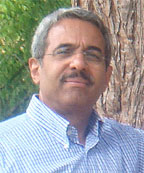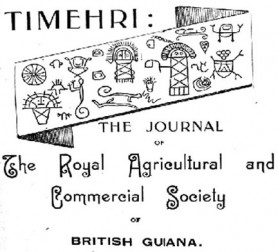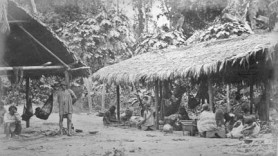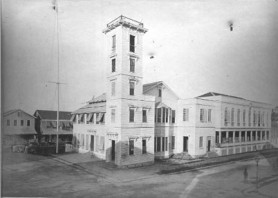In February 1844 an Agricultural and Commercial Society was founded in Georgetown British Guiana; the institution later achieved Royal patronage to become The Royal Agricultural and Commercial Society (RA&CS). William Campbell, a Scottish attorney, had the idea to set up a Society and proposed that the institution should be an Agricultural Society, a Commercial News Room, an Exchange Room, a Museum and Model Room, a Library and a scientific society. The Society thus became the focus for intellectual, scientific, cultural and commercial life for the planters and the elite in British Guiana during the colony’s development in the 19th century. The Society gave its members the opportunity to read papers on agricultural and commercial matters and to discuss the Colony’s history and social problems, and from 1882 published the journal named ‘TIMEHRI’. After Guyana became an independent Republic in 1970, the Royal Agricultural & Commercial Society was renamed the ‘Guyana Society’ until its demise in the 1990s. Today the only visible reminder of the Society’s existence in Georgetown are the large initial letters R A C S carved in relief over the entrance to the old Reading Room building adjacent to the Guyana Museum.

Organ of the Society
One of the Society’s objects had been the “establishing and carrying on of a periodical publication as the organ of the Society…” From its foundation in 1844, the Society’s public notices and minutes of general meetings were fully reported in the Royal Gazette of British Guiana. However, it was not until ten years later that an attempt was made to fulfill this object of publishing a journal. In 1854 the RA&CS published two issues of the British Guiana Journal of Useful Information in Literature Science and the Arts; but this publication failed to attract subscribers and the publication was ceased in the same year.
The Society did occasionally publish information about the colony; technical pamphlets discussing matters of local interest as well as essays on various themes. William Russell, a sugar planter, took a great interest in the Society and from 1875 he offered valuable money prizes for essays on empoldering, fallowing, drainage of land and the manufacture of sugars, rum, fibres and grasses.
William Russell held the office of President of the RA&CS on five occasions between 1871 and 1885. In 1881, as the elected President of the Society, Russell moved that the proceedings of the RA&CS meetings be printed and he resolved to publish a bi-annual journal. It was not until 1882, twenty eight years after the founding of the RA&CS, that the Society’s requirement for a journal was eventually achieved with the publication of the new Journal titled TIMHERI: The Journal of the Royal Agricultural and Commercial Society of British Guiana. In 1882 Mr. Everard im Thurn, who was then the Curator of the British Guiana Museum, was authorised to publish a journal of the Society, which in the words of James Rodway “undoubtedly brought the Society before the world.”

Prospectus
The Creole newspaper of 17th February 1882 published the Prospectus which announced the object of the Journal:
“The journal [TIMEHRI] which is to be published half yearly on the 30th June and 1st December, is intended to contain not only or briefly a record of the proceedings of the Society of which it is to be the organ, but also papers and occasional notes on agricultural, commercial, geographical, meteorological, chemical, botanical, ornithological, anthropological and literary subjects concerned with British Guiana. A Meteorological Record, will as it can be organised, form a regular centre of the journal. Lists of the known flora and fauna of the country will be given from time to time, as they can be prepared. A series of the vocabularies of the Indian languages of Guiana is also in preparation.”
Scope and coverage
TIMEHRI provided an outlet for the publication of the work of amateur naturalists and observers of the social life in colonial British Guiana. It was also served as a forum for more technical papers on agricultural and scientific topics written by specialists. The articles in the Journal were to a large extent the work of English expatriates writing about the history of the colony or about those aspects of its practical life that interested them as administrators and planters, or persons connected with these activities in some professional capacity.
The scope of TIMEHRI covered the Society’s proceedings as well as matters of scientific interest connected with the development of British Guiana’s natural resources and colonial history. Here are but a few examples of topics covered during its publication history: Early developments in agricultural science, particularly the sugar industry, and the encouragement of new crops and industries such as timber and mining; exploration reports ranging from those of Robert Schomburgk, the early expeditions to Roraima by Everard im Thurn, John Quelch, Cecil Clementi and his wife and Richard Attenborough’s “Zoo quest to Guiana”; ethnographic studies of the native Amerindian cultures and languages; descriptive taxonomy of the country’s flora and fauna, education and the arts; the abolition of Roman Dutch law and other philosophical and literary topics which provided an insight into the cultural and intellectual life of the country.

Although the discussion of politics was prohibited within the Society, a fine line was occasionally crossed when the weight of the Society’s influence was put upon the Government; thus in the pages of TIMEHRI we find members of the Society promoting hinterland development through the expansion of the railway into the heartland of the colony and the planters’ clamour for a larger labour force of indentured immigrants.
Distinguished Editors
Throughout TIMEHRI’S publication life the journal was honoured with a long genealogy of distinguished editors, men who were scholars and naturalists in their own right – im Thurn, Quelch, Rodway, Nunan and Roth. All but one of these gentlemen had held curatorial positions at the British Guiana Museum. Beside their editorial roles, they also contributed articles to the journal drawing on their personal scientific observations and travels undertaken throughout Guyana’s unexplored hinterland. One should of course include Messrs. Cox and Hubbard for their later valiant achievement in reviving and editing the final TIMERHRI issue in 1990.
Everard im Thurn
In 1882 Everard im Thurn (later Sir) became the founder-editor of the Society’s journal. In that year he was also appointed Magistrate for the Pomeroon District having served as the Curator of the British Guiana Museum. im Thurn had the dilemma of choosing a title for the new journal – he decided on a title which was not at all descriptive of the journal’s contents; im Thurn named the new journal TIMEHRI: The Journal of the Royal Agricultural and Commercial Society of British Guiana. ”. im Thurn also advised that the latter two syllables of the word TIMEHRI should be pronounced as though rhyming with ‘merry’.

In his first editorial prologue which appeared in TIMEHRI June 1882, im Thurn explained the origin and significance of the title TIMEHRI; he understood ‘timehri’ to be a Carib word signifying certain marks or figures, the name after the Amerindian picture writing found on the rocks in some of Guyana’s rivers. im Thurn writes: “So in Egypt the hieroglyphs, so in Guiana these ‘timehri ‘ stand as records of a forgotten time”. He goes on to encourage “… individuals with special knowledge” to share this knowledge and create a permanent written record for the colony.
In 1885 im Thurn published the account of his first ascent of Mount Roraima. In these early volumes of TIMEHRI he was also able to reprint and promote the work of Robert and Richard Schomburgk whose written accounts of their surveys of British Guiana pre-dated the existence TIMEHRI. Everard im Thurn’s own work of anthropology and travel, ‘Among the Indians of Guiana”, being ethnographic sketches of the native Amerindians and an account of the country’s flora and fauna, was widely reviewed and acknowledged by British learned societies in 1883.
im Thurn’s period of editorship ended in 1886 when he resigned along with other members of the RA&CS Executive over a disagreement about the motion passed by the Society to reduce members’ subscription rates in 1886.
J J Quelch
The severance of Everard im Thurn was a great loss to the RA&CS. John Joseph Quelch, then Curator of the British Guiana Museum and a former zoologist at the British Museum, was asked by the Directors of the Society to undertake the editorship of TIMEHRI in 1887. The RA&CS Board had decided that half of the journal would be devoted to the Society’s proceedings and fuller reports of meetings while the other half would contain original papers on scientific reports and subjects of a more general interest.
J. J. Quelch was punctilios in carrying out this editorial brief. He was meticulous in reporting the RA&CS meetings as well as his own prolific output of scientific notes and reports which appeared in TIMEHRI. His expeditions to Mount Roraima in 1894 and 1898 added much to the wealth of the collections of the British Guiana Museum and his manner of explaining the Museum exhibits to visitors left nothing to be desired.
While Everard im THURN was primarily an anthropologist, Quelch was a naturalist with particular interests in ornithology which he demonstrated in his notes which were published in TIMEHRI. His scientific contributions to TIMEHRI were highly appreciated by academics of institutions in other countries. Moreover, Quelch was instrumental in promoting British Guiana overseas through his presentation of local products and native artefacts for shipment to international exhibitions in Paris, Chicago and London. The Imperial Institute in London became one of the main beneficiaries of this cultural exchange.
Quelch produced the New Series of TIMEHRI up to 1893 after which he resigned the editorship on account of a year-long trip which took him to the United States of America as The British Guiana Commissioner to the World’s Columbian Commission Exposition in Chicago, 1893. A set of TIMEHRI journals appeared as one of the prize winning exhibits from British Guiana at the Chicago exhibition. Quelch’s correspondence and reports on the setting up and progress of the exhibition in Chicago were duly published in TIMEHRI.
James Rodway
James Rodway, in addition to his roles as the Society’s Librarian and Secretary, became the acting Editor of TIMEHRI in 1893 while Quelch was abroad, and he continued editing the journal up to 1898. In 1894 the RA&CS celebrated its Fiftieth Jubilee and during those fifty years since its establishment a social revolution had taken place in British Guiana and this was mirrored in the Society’s published proceedings and correspondence.
Rodway himself was a regular contributor to TIMEHRI; the articles he wrote were informative and lively, even a little mischievous at times, but they reflected his instinctive observations of the happenings in the Colony. The scope of his literary output was vast and varied, ranging from antiquarian studies and societal commentary to natural history and fiction.
He wrote in a pleasant readable style, and possessed a gift for picturesque description which served him in good stead in depicting the “wonderful country” to which he devoted his long life.
Rodway was adept at keeping the Society’s work and purpose alive by reminiscing about its history. Writing in TIMEHRI in 1918, fifty years after im Thurn’s adoption of the name TIMEHRI for the title, Rodway found it appropriate that the journal itself should contain some account of the pictured rocks from which the journal derived its name. The Museum was in possession of the two pieces of rock which bore the pictograms of the dancing figures. Rodway provides us with a lengthy discourse on the block of figures reproduced on the cover and title page of TIMEHRI. The dancing figures reproduced on the journal cover were to become an enduring logo for the title.
Joseph Nunan
The resurrection of TIMEHRI in 1911 after a gap of twelve years was entirely due to the initiative and energy of Dr Joseph John Nunan, the Attorney General. This up-turn spurred a large diverse range of articles to flood into the RA&CS. The Directors appointed an Editorial Committee comprised of Government specialists, academics, editors of the local newspapers and the current editors of TIMEHRI. The selection of an editor in chief rested with the Editorial Committee and Dr Nunan became editor of the Third Series of TIMEHRI journals which were published between 1911-1921. James Rodway took on the editorial role once more – this time as the assistant editor.
Under the editorship of Nunan and Rodway, individual issues of the journal were given thematic titles which brought together articles reflecting the sentiments of the times. In 1912 the “Colony Volume” featured the Colony’s activities; In the “War Volume” 1917, Dr Nunan, the Editor, makes an elaborate announcement of the programme of the Society and TIMEHRI during the forthcoming year. The “Historical Illustrated Volume” 1918, included photographic plates and the “Colonization Volume” 1919 in which most of the articles have some bearing upon the great problems of populating the Colony with immigrant indentured labour. TIMEHRI, August 1921, entitled “Progressive Volume”, contains an article by James Rodway who, in response to the Society’s critics, writes of the period between 1870 – 1920 in which “we may say plainly in spite of the croakers there has been considerable progress … we have tried to show that our Colony is really progressive…” This progress also meant that the Creole members of the Society were gradually able to voice their opinions through the pages of TIMEHRI.




